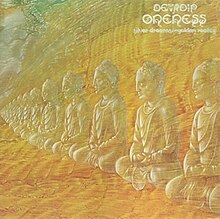Oneness(Carlos Santana album)
| Oneness: Silver Dreams - Golden Reality | ||||
|---|---|---|---|---|
 | ||||
| Studio album/Live albumby | ||||
| Released | March 1979 | |||
| Recorded | December 1977–1978(A1–A6 recorded live atOsaka Kōsei Nenkin KaikaninOsaka, Japan;A7–B6 recorded atThe AutomattinSan Francisco, California) | |||
| Genre | ||||
| Length | 45:55 | |||
| Label | Columbia | |||
| Producer | Devadip Carlos Santana | |||
| Devadip Carlos Santanachronology | ||||
| ||||
Oneness: Silver Dreams - Golden Realityis a 1979albumbyCarlos Santana.It was his second of three albums (the others beingIlluminationsandThe Swing of Delight) to be released under his temporarySanskritnameDevadipCarlos Santana, given to him bySri Chinmoy.The album, which consists mostly of instrumental songs and ballads, features members of the bandSantana,as well as Carlos Santana's first wife Deborah and father-in-lawSaunders King.[1]According to Santana,Onenesswas influenced byWeather Report's albumMysterious Traveller.[2]The track "Transformation Day" is an adaptation of part ofAlan Hovhaness's symphonic workMysterious Mountain.[1]
Reception
[edit]| Review scores | |
|---|---|
| Source | Rating |
| AllMusic | |
| Christgau's Record Guide | B−[4] |
| The Encyclopedia of Popular Music | |
| The Rolling Stone Album Guide | |
A writer forBillboardnoted Santana's "extraordinary guitar work," and called the album "a musical excursion into various moods and feelings."[7]CriticRobert Christgaudescribed the album as "frustrating," calling it "spiritual program music that mixes genuinely celestial rock with the usual goop."[4]TheBay State Banneropined that, "at this point, Santana would be well-advised to rid himself of Greg Walker's vocals, which are empty and corny."[8]The New York Timesnoted that "too much of the time is spent wallowing in benign platitudes."[9]
In a review forAllMusic,William Ruhlmann noted that "the difference between a group effort and a solo work seems to be primarily in the musical approach, which is more esoteric, and more varied than on a regular band album."[3]Rob Caldwell ofAll About Jazzstated that "though this was essentially [Santana's] first solo record, it marked the work as a definite remove from any 'Santana sound'." He wrote: "Onenessis much more accessible thanIlluminationsand more likely to appeal to fans of the band. Gone are the lengthy and often meandering tracks..., and Santana explores many avenues of expression. "[10]
Musicologist Melinda Latour described the title track as "a particularly clear example of Santana's attempt to transcend to another plane through tone," in which he "builds a sense of spatial transcendence," leading to "an explosion of upper partials that carry the end of a note upward into a new dimension."[11]
Track listing
[edit]All tracks written byCarlos Santana,except where noted.
| No. | Title | Writer(s) | Length |
|---|---|---|---|
| 1. | "The Chosen Hour" | 0:36 | |
| 2. | "Arise Awake" | 2:05 | |
| 3. | "Light Versus Darkness" | 0:48 | |
| 4. | "Jim Jeannie" | Chico Hamilton | 3:30 |
| 5. | "Transformation Day" | Alan Hovhaness,Santana | 3:45 |
| 6. | "Victory" | 1:10 | |
| 7. | "Silver Dreams Golden Smiles" | Tom Coster,Santana, Greg Walker | 4:09 |
| 8. | "Cry of the Wilderness" | 3:11 | |
| 9. | "Guru's Song" | Sri Chinmoy | 3:06 |
| Total length: | 22:15 | ||
| No. | Title | Writer(s) | Length |
|---|---|---|---|
| 1. | "Oneness" | 6:21 | |
| 2. | "Life Is Just a Passing Parade" | 5:15 | |
| 3. | "Golden Dawn" | 2:17 | |
| 4. | "Free as the Morning Sun" | 3:16 | |
| 5. | "I Am Free" | Sri Chinmoy,Santana | 1:27 |
| 6. | "Song for Devadip" | Narada Michael Walden | 5:03 |
| Total length: | 23:37 | ||
Personnel
[edit]- Greg Walker –vocals(1, 11, 13)
- Deborah Santana – vocals(14)
- Carlos Santana–electric guitar,vocals
- Chris Solberg – guitar(5,11),Hammond organ(5, 11)
- Saunders King– guitar, vocals(7)
- Tom Coster–keyboards,vocals
- Narada Michael Walden–piano,Hammond organ(9, 15)
- Bob Levy –strings,synthesizer(6)
- Chris Rhyne – keyboards(11)
- David Margen –bass guitar
- Graham Lear–drums
- Pete Escovedo–timbales(6)
- Armando Peraza–percussion,vocals
- Clare Fischer–string arrangementsandconductor;piano(7, 12)
Charts
[edit]| Chart (1979) | Peak position |
|---|---|
| Australian Albums (Kent Music Report)[12] | 39 |
| Finnish Albums (The Official Finnish Charts)[13] | 25 |
| UK Albums(OCC)[14] | 55 |
| USBillboard200[15] | 87 |
References
[edit]- ^abWeinstein, Norman (2009).Carlos Santana: A Biography.Greenwood Press. p. 61.
- ^Santana, Carlos (2014).The Universal Tone: Bringing My Story to Light.Little, Brown.
- ^abRuhlmann, William (2011)."Oneness: Silver Dreams Golden Reality - Carlos Santana | AllMusic".AllMusic.com.Retrieved28 August2011.
- ^abChristgau, Robert."Consumer Guide Album: Devadip Carlos Santana: Silver Dreams Golden Reality".RetrievedOctober 2,2023.
- ^Larkin, Colin, ed. (2002).The Encyclopedia of Popular Music.Oxford University Press. p. 1088.
- ^DeCurtis, Anthony; George-Warren, Holly; Henke, James, eds. (1992).The Rolling Stone Album Guide.Random House. p. 264.
- ^"Billboard's Top Album Picks".Billboard.March 10, 1979. p. 86 – via Google Books.
- ^Lane, George (26 Apr 1979). "Shades of Blue".Bay State Banner.No. 29. p. 17.
- ^Rockwell, John (9 Mar 1979). "The Pop Life: Why Santana has survived the 1970's".The New York Times.p. C26.
- ^Caldwell, Rob (August 15, 2015)."Carlos Santana: Light Of The Supreme: Carlos Santana's Devadip Trilogy".All About Jazz.RetrievedOctober 2,2023.
- ^Latour, Melinda (2018). "Santana and the Metaphysics of Tone: Feedback Loops, Volume Knobs, and the Quest for Transcendence". In Fink, Robert; Latour, Melinda; Wallmark, Zachary (eds.).The Relentless Pursuit of Tone: Timbre in Popular Music.Oxford University Press. p. 219 – via Google Books.
- ^Kent, David(1993).Australian Chart Book 1970–1992(illustrated ed.). St Ives, N.S.W.: Australian Chart Book.ISBN0-646-11917-6.
- ^Pennanen, Timo (2006).Sisältää hitin – levyt ja esittäjät Suomen musiikkilistoilla vuodesta 1972(in Finnish) (1st ed.). Helsinki: Kustannusosakeyhtiö Otava.ISBN978-951-1-21053-5.
- ^"Official Albums Chart Top 100".Official Charts Company.Retrieved June 15, 2024.
- ^"Santana Chart History (Billboard200) ".Billboard.Retrieved October June 15, 2024.
